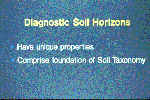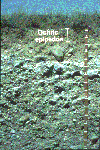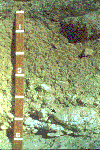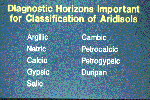Classification, Properties, and Management of Aridisols
Introduction to Soil Horizons
 |
Soil horizons which have unique morphologic, chemical and mineralogic
properties are called diagnostic horizons. These horizons form the
foundation of soil classification in Soil Taxonomy.
|
 |
Diagnostic horizons formed at the soil surface are called epipedons.
The light colored surface horizon found in most Aridisols is called
an ochric epipedon. The term epipedon is derived from the Greek
word epi meaning "over," and pedon meaning "soil."
Ochric is derived from the Greek word ochros meaning "pale."
|
 |
Due to the low amount or absence of leaching associated with the
aridic soil moisture regime, Aridisols normally have one or more
subsurface soil horizons in which suspended or dissolved minerals
have been deposited.
|
 |
Nine diagnostic subsurface soil horizons are important in the classification
of Aridisols. These horizons have accumulations of silicate clays,
sodium, calcium carbonate, gypsum or soluble salts. These horizons
can also be cemented by carbonates, gypsum or silica.
|
Introduction to Aridic Soils | Soil Taxonomy | Introduction to Soil Horizons | The Horizons | Suborders and
Great Groups | Argid Suborder | Orthid Suborder | Subgroups | Families
| Non-Aridisols | Irrigation
| Saline Soils | Sodic
and Saline-Sodic Soils | Final Considerations
|

